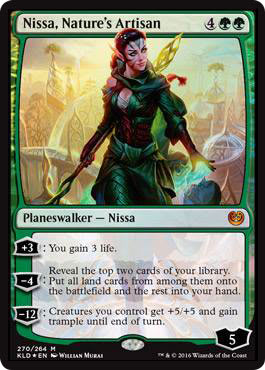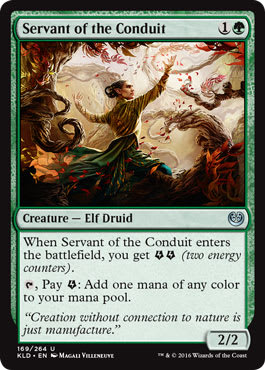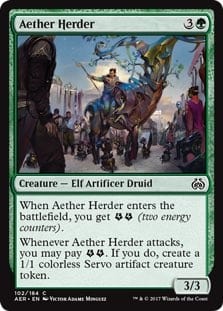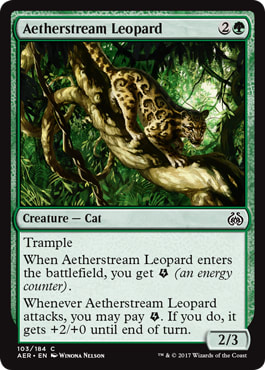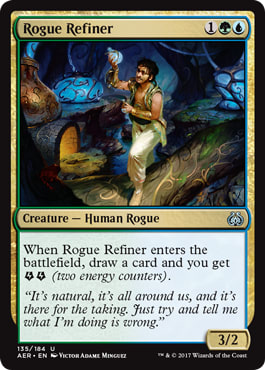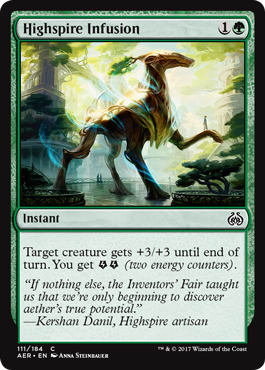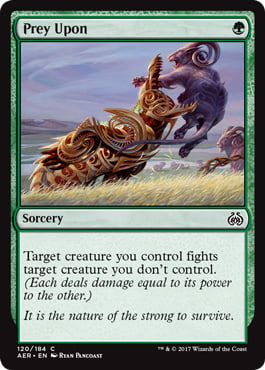Challenge accepted, Karl!
You’ll recall that Kaladesh introduced us to the first two Planeswalker Decks, which ended the long run of the Intro Packs that had lasted since 2008’s Shards of Alara. Each deck highlighted both a Planeswalker theme, including an actual Planeswalker card, as well as one or more mechanics from the set. For Kaladesh, that gave us an energy deck headed by Nissa, Nature's Artisan (Meddled here), as well as a Vehicles deck with Chandra, Pyrogenius (here).
Today we’ll be revisiting both decks, and looking what cards from Aether Revolt might content for a place on the bench. Before we begin, for any new readers we’ll start by defining “Meddling.” Meddlings are where we take a Preconstructed deck, tear it down to its core themes and elements, then rebuild it in a more streamlined and improved form. While the decks vary, all Meddlings have two golden rules in common, which help ensure the finished product is both easily-attainable as well as budget-friendly.
- The first rule is that I can only add in commons and uncommons — no rares or mythics. Any the deck comes with can be kept, but if we can’t reinforce a deck’s theme using only readily-available commons and uncommons, then perhaps it’s not a theme to begin with.
- Second, we can only draw from sets already present in the deck. This keeps the card pool contemporary, with only the newest set or two available for consideration. Of course, today we’ll be taking our meddled Kaladesh decks and revisiting them through the lens of Aether Revolt!
Let’s begin! Here’s the deck we came up with for Nissa last October.
Meddled Nissa ? Planeswalker Deck| Jay Kirkman
- Creatures (20)
- 1 Aethersquall Ancient
- 1 Bristling Hydra
- 2 Arborback Stomper
- 4 Long-Finned Skywhale
- 4 Longtusk Cub
- 4 Servant of the Conduit
- 4 Thriving Turtle
- Planeswalkers (1)
- 1 Nissa, Nature's Artisan
- Instants (4)
- 4 Blossoming Defense
- Sorceries (6)
- 2 Verdant Crescendo
- 4 Attune with Aether
- Enchantments (2)
- 2 Aether Meltdown
- Artifacts (0)
- Lands (24)
- 11 Forest
- 9 Island
- 4 Woodland Stream
The meddled Nissa deck was tightly focused on energy production and consumption. Indeed, we’d even trimmed down the Planeswalker subtheme through cutting the Guardian of the Great Conduits — conditional cards that were only decent when Nissa herself was in play.
The deck was happy to stall and ramp in the early game, with playsets of Thriving Turtle and Servant of the Conduit. The latter could help ramp into one of the four Long-Finned Skywhales intended as a closer, while Bristling Hydra and Longtusk Cub gave us uses for any extra energy we may have accumulated to put them to good purpose. Verdant Crescendo helped with the land drops (as well as tutoring for Nissa), while Attune with Aether did the same while helping with energy.
Throw in some creature pumping with Blossoming Defense, and a splash of threat countering with Aether Meltdown, and we had a nicely-focused Planeswalker deck that more than made up in consistency what it might have sacrificed in variety.
Of course, there’s always room for improvement. Did Aether Revolt bring us anything that might upgrade the deck?
The Creatures
Looking at the Blue, Green, and Colorless options in Aether Revolt, it doesn’t seem to be a crowded field waiting to get in, but we do have some creatures that tie in with the energy mechanic. As with most energy cards, each bring a little bit of energy along with them, and a way to use it.
Aether Herder offers us a 1/1 Servo if we spend energy when it attacks. This might be amusing if it was repeatable, letting us make a swarm of Servos with any energy we might have accumulated. Alas, it’s a one-time deal each attack phase, and is contingent upon the Herder surviving the previous turn’s attack. While Aether Revolt has a solid artifacts-matter mechanic in improvise that might welcome the ability to generate Servos, is there a use for it here?
Let’s hit the pause button on energy for a moment and discuss improvise. The improvise mechanic is a sort of fixed affinity for artifacts, the legendary mechanic that broke the game back in 2003’s Mirrodin. Affinity for artifacts made cards with it cost less for each artifact you had in play. With improvise, your artifacts can be tapped for mana to help pay for the spell. That can have a similar effect but it’s much more limited since each artifact can only contribute once.
Aether Revolt offers us four creatures in the deck’s colors: Barricade Breaker, Bastion Inventor, Foundry Assembler, and Wind-Kin Raiders. While being able to connect to energy isn’t a prerequisite, they’d have to be able to stand on their own. Alas, none of the four do here, where we’re only running a trio of artifacts. Thus, it seems we can safely bypass improvise, as well as artifact-generating cards like this and Aether Swooper.
Back to energy, Aetherstream Leopard is an interesting card, and somewhat brings to mind the landfall mechanic. The first time around in Zendikar, landfall brought sizable bonuses to early creatures like the Steppe Lynx and Plated Geopede. When Battle for Zendikar brought it back, the landfall bonuses were noticeably smaller. The Leopard offers us energy on a diminished scale, coming into play with only one energy and needing only one to ‘activate.’ Neither that, nor its stating relative to cost, make this an attractive option.
At last, we do see a promising candidate in the Peema Aether-Seer. Although a 3/2 for 4 mana isn’t a very good deal, the Aether-Seer holds out the opportunity to churn out a decent dose of energy. The question then becomes, is it worth it? It’s easy to envision the tidy return we’ll get when we’ve got a Long-Finned Skywhale in play (or even the Aethersquall Ancient), and that would certainly help fuel the Ancient’s Evacuation ability, or help grow the Cub or Hydra.
Unfortunately, the creature field is a little dense. We don’t want to lose the ability to build up in the early game, making the cheaper creatures safe. Nor do we want to cut into our most effective closers, the Long-Finned Skywhale. Unless we’re willing to cut a rare (the Ancient or Hydra), then the only thing we might see subbing the Peema Aether-Seer in for is the Arborback Stomper.
Is it worth losing the 5 power of trampling offense, not to mention the nice chunk of lifegain? Probably not. There’s not a lot of point in adding a card to help make the Longtusk Cub better, when it replaces a card that is already a better Longtusk Cub.
The Peema Aether-Seer’s ability is also contingent upon us already having something of decent size on the battlefield. If we were that hungry for energy, we might also look at the Reservoir Walker, a 3/3 artifact creature that brings along a trio of energy counters. While the extra energy is nice, the 3/3 body it leaves behind doesn’t do much to help us in the red zone.
It looks like Aether Revolt is something of a bust for us, but then we find a card like the Rogue Refiner. This three-mana 3/2 is nicely aggressive, giving us 3 power on the board, two energy counters, and letting us draw a card to replace it in hand. Is a 3/2 better than the 5/4 Arborback Stomper? When we look at it as simple stats, no, but to really answer the question we need to ask ourselves what each card would do for the deck.
The Arborback Stomper is in because it’s a solid, efficient closer. Sure, we have a number of other options for that job- the Ancient, Hydra, and four Skywhales give us six cards to close out our opponent with. Two Stompers round that out to a nice, even eight. The five points of life is a nice bonus that will occasionally be useful when we’re behind, giving us the gift of a little more time. More often, though, it won’t be necessary- particularly when the deck is doing what we want it to do (stall, ramp, and close).
So what does the Refiner offer? Well, for one thing, it’s a 3-drop in a deck that doesn’t have any (unless you count sacrificing the Glassblower's Puzzleknot). This lets us potentially curve out very efficiently, chaining together a Thriving Turtle, Longtusk Cub, then Refiner. If we pull that off, we can be swinging in with a 4/4 beater on turn three (the Cub, with the energy from the Turtle and Refiner pumped into it) that will offer up two energy counters if it lands a paw on our opponent.
This is an excellent line of play that can give our deck some very early momentum. The opportunity to put the game in our favor early rather than late (with the Arborback Stomper) makes this a worthwhile upgrade. The Refiner is in!
Next up is the Shielded Aether Thief. Now this is another interesting card. It’s a 0/4 with flash, meaning we’ll almost always get to use it as a surprise blocker. And every time it blocks, we gain an energy counter. That’s already interesting, since stalling out the red zone is part of what we want our deck to do (using the Thriving Turtle). But the Thief has one more trick up its sleeve, letting us draw a card for three energy.
Taken together, that seems tempting. But it also seems like something of a trap. That 0 power means that this card can’t help us win (unless we burn a Blossoming Defense on it in a pinch). So it’s not an answer, even if it does help us find other answers through the card draw. But three energy is not a small cost. We only have so many ways to generate energy in this deck, and none of them are open-ended. In other words, energy is a mainly finite resource — once it’s gone, there are few ways to get any more (connecting with the Cub is the only renewable source).
The Thief solves that problem by being renewable — whenever it blocks, we get energy — but in the end it just pulls too much away from the rest of the deck. What would you rather draw, this or the Cub? This or the Refiner? Unless you’re taking an early beating, those other cards are going to be better every time. And there’s little sense trying to avoid the occasional beating if it means we’re going to win less overall. The Thief is a really intriguing card and great design — but not one that belongs here.
Finally, there’s the Shipwreck Moray. While the Moray brings in four energy counters, it’s another 0-power creature that doesn’t do a lot to advance the board state outside of congesting the red zone. Sure, we can burn an energy to pump it up, but it’s preferable to channel energy through the Cubs and Hydra, who get a permanent rather than temporary bonus from them.
There’s little to regard in the rest of the creatures. For Aether Revolt, they mainly involve artifact-matters themes, which we don’t employ, or the revolt mechanic. Which we also don’t employ. Next, let’s take a look at the noncreature support!
Spells
We have nine instants to consider here, but only one of them plays into our theme. Highspire Infusion is a pump spell that not only temporarily buffs a creature, but also gives us some energy. Previously we’d used Blossoming Defense, which gave a smaller boost in addition to hexproof. The latter ability was useful in that it helped prevent our creatures from being taken out by removal, but Highspire Infusion is much more proactive. Simply put, there are going to be many more times that the new spell will be fully relevant versus the old one, and so it’s an easy swap to make.
For sorceries, there are only three. One draws cards (Reverse Engineer), the other two are removal (Monstrous Onslaught and Prey Upon). Although Prey Upon is tempting, it may be more of a sideboard card. Our removal is scant in this deck, but instead the support suite is used to generate energy through Aether Meltdown (which also hits Vehicles) and Glassblower's Puzzleknot. We’re less worried about creature removal thanks to being able to either stall out an opponent’s early attack with the Turtle, or the potential for early aggression with a pumped-up Cub.
For enchantments, we have similarly slim pickings (Efficient Construction, Ice Over, Unbridled Growth) that add little to the deck.
Finally, with (non-creature) artifacts, there is one that’s worth a look — the Consulate Turret. The Turret lets us deal damage directly to our opponent for three energy, while being a renewable source of energy all game long. That’s intriguing, but if we look at it from a “carbon neutral” footprint (where input = output) then the Turret we cast on turn three is dealing 2 points of damage on turns 6, 10, 14, and so on. That’s awfully slow, and not worth the inclusion. The Glassblower's Puzzleknot — admittedly one of the deck’s weaker inclusions — is still offering up four energy over two turns for 5 mana, and letting us scry twice.
So after looking at what Aether Revolt has to offer, here’s the decklist for the re-Meddled Nissa deck!
Aetherized Nissa ? Planeswalker Deck | Jay Kirkman
- Creatures (22)
- 1 Aethersquall Ancient
- 1 Bristling Hydra
- 4 Long-Finned Skywhale
- 4 Longtusk Cub
- 4 Rogue Refiner
- 4 Servant of the Conduit
- 4 Thriving Turtle
- Planeswalkers (1)
- 1 Nissa, Nature's Artisan
- Instants (4)
- 4 Highspire Infusion
- Sorceries (6)
- 2 Verdant Crescendo
- 4 Attune with Aether
- Enchantments (2)
- 2 Aether Meltdown
- Artifacts (1)
- 1 Glassblower's Puzzleknot
- Lands (13)
- 9 Island
- 4 Woodland Stream
Let me know your thoughts in the comments below, particularly if there was something you would have done differently. Join me next week, when we look at the Chandra deck!














